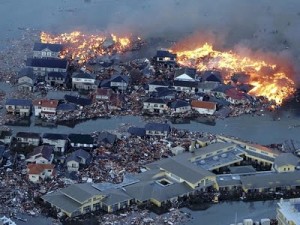 The disasters that plagued the globe this year will send 2011 into the record books as the most costly year for catastrophes on record.
The disasters that plagued the globe this year will send 2011 into the record books as the most costly year for catastrophes on record.
Japan’s powerful tsunami, earthquakes in New Zealand, floods in Thailand and a series of severe tornadoes in the U.S. all contributed to $350 billion in disaster losses, according to a new estimate from reinsurance company Swiss Re AG.
The long list of calamities crippled factories and cut supply chains, rippling through the world’s economies. In Christchurch, New Zealand, entire city blocks remain uninhabitable; in Alabama and Missouri, neighborhoods have been wiped off the map.
Insurance and reinsurance companies are likely to shoulder about $108 billion of the losses, though the tally could creep higher, Swiss Re said.
The insurance industry’s burden would have been greater except for the relatively low uptake for earthquake and tsunami coverage in Japan, where the government, businesses and individual homeowners are footing the bulk of the bill. To a lesser degree, the same was true in August’s Hurricane Irene, where wind damage in the U.S. was covered—but flooding, in many places, was not.
Such uninsured losses have been a drag on the global economy, said Robert Hartwig, an economist and president of the Insurance Information Institute, a trade group. He estimated total economic losses arising from catastrophes equaled about 0.5% of the global economy this year.
While insurers absorbed less than one-third of the year’s disasters, 2011 is the second-most costly year for the insurance industry, behind only 2005, when Hurricanes Katrina, Rita and Wilma helped push the global tally to $123 billion.
In response to the near-record claims this year, insurers are increasing how much they charge for catastrophe coverage around the globe, re-evaluating their exposure to disaster-prone areas, and tightening policy terms. How much ultimately will be passed on to U.S. consumers, however, is unclear, as most states regulate home-insurance rates. Disaster modelers are studying the science behind each calamity to improve their predictions of losses for future events, and underwriters are examining their clients’ supply chains for signs of weakness.
“The losses were very global in nature and in places that folks didn’t think they would lose a ton of money from,” said Al Tobin, the national property practice leader at Aon Risk Solutions. “Lots more questions are coming from insurance carriers” as they evaluate policyholders’ risks and re-price coverage, he said.
While a handful of smaller insurers have been seized by regulators, including at least three in Missouri, as a result of this year’s disasters, Mr. Hartwig said the overall property-casualty industry remains robust after entering the year with “record claims-paying capital.”
The catastrophes also exacted a steep toll in terms of lives lost, and the numbers don’t illustrate the devastation left in their wake. State Farm catastrophe-claims representative Jasmine Coleman recalled an “eerie quiet” when she drove into Joplin, Mo., about 24 hours after tornadoes swept through there in May. As she neared ground zero, “trees were completely stripped bare of bark, leaves, branches. Power lines were down. There were massive amounts of debris,” she said Thursday. “You saw people walking around. They looked aimless in a way, but they were looking for belongings, momentos, in piles of rubble.”
The insured damage from the Joplin tornadoes totaled $6.7 billion, according to Swiss Re, the fifth costliest event of the year. The damage came on the heels of a series of tornadoes that swept from Alabama to Virginia, causing $7.3 billion of insured damage.
Jim Edens, Allstate’s senior claim field director for its National Catastrophe Team, dispatched six mobile claims centers in a line from Tuscaloosa, Ala., to Bristol, Va., to quickly handle those claims. The storm system “was so powerful that the path it left was just dirt. It sucked the leaves, the bark, the trees, the shrubs, the grass out of the ground. It left nothing but the earth,” he remembered Thursday.
Yet disaster experts said the global tally could have been even higher. Hurricane Irene lost much of its strength before barreling into New York City, causing relatively little damage in the city. Mr. Tobin of Aon said the Japan earthquake would have been more devastating had it severely impacted Tokyo. And Jon Hall, an executive vice president at property insurer FM Global, said flooding in China’s Pearl River Delta instead of Thailand would have crippled the source of 38% of the world’s electronics.


